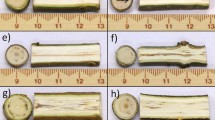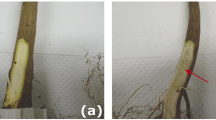Abstract
One of the greatest threats to the native ecosystems in any part of the world is the invasion and permanent colonization of ecosystems by non-native species. Florida is no exception to this biological invasion, and is currently colonized by an extensive variety of exotic plant species. Originally imported from Asia over 30 years ago, Old World Climbing Fern Lygodium microphyllum (Cavanilles) R. Brown) has become one of the most invasive and destructive weeds in southern Florida. To date different effective control measures of its growth and spread have not been successful; fire and herbicide applications that are currently employed are neither cost effective nor environmentally friendly. In light of the highly delicate ecosystem that is being affected by L. microphyllum, we tested the soil fungus Myrothecium verrucaria (Albertini and Schwein) Ditmar: Fr. for its pathogenicity on the invasive fern. In greenhouse studies the effect of two conidial concentrations of M. verrucaria on L. microphyllum was investigated. Plants were spray inoculated with M. verrucaria which resulted in successful disease development with leaf necrosis symptoms. The higher conidial concentration (1 × 108 ml−1) produced a disease index of approximately 3 on a scale of 0 to 4, day 24 postinitial inoculation, demonstrating the efficacy of this fungus as a severe retardant of Lygodium growth. Preliminary screening of selected native plant species for susceptibility to M. verrucaria showed low disease indices after repeated spray inoculations; the highest index attained was 0.4 by Slash pine (Pinus elliottii).
Similar content being viewed by others
References
Abbas H.K., Tak H., Boyette D., Shier W.T., Jarvis B.B. (2001) Absence of macrocyclic trichothecenes from kudzu (Pueraria montana) plants treated with a high producing isolate of Myrothecium verrucaria. Phytochem. 58: 269–276
Beckwith, J.R. and C.W. Dangerfield, 1996. Forest resources one-lines. Extn. For. Res. Unit, Bull. For., 96-040, Georgia Coop. Extn. Serv., Univ. GA Press, Athens, GA.
Boyette C.D., Walker H.L., Abbas H.K. (1999) Biological control of kudzu (Pueraria montana) with an endemic fungal pathogen. Proc. South. Weed Sci. Soc. 52: pp. 237
Charudattan R. (2001) Biological control of weeds by means by means of plant pathogens: Significance for integrated weed management in modern agro-ecology. BioControl 46: 229–260
Domsch, K.H., W. Gams and T. H. Anderson, 1980. Myrothecium. In: Compendium of Soil Fungi. vol. 1, Academic Press, New York. pp. 481–487
Farr D.F., Bills G.F., Chamuris G.P., Rossman A.Y. (1989) Fungi on Plants and Plant products in the United States. American Phytopathological Society, St. Paul, MN
Ferriter, A., 2001. Lygodium Management Plan for South Florida. Florida Exotic Pest Plant Council Lygodium task force
Grosu R., Hulea A. (1973) Morphogenesis, sporogenesis, and cultural and physiological features of M. verrucaria. Rev. Roum. Biol. Ser. Bot. 18:219–225
Kuti J.O., Ng T.J., Bean G.A. (1987) Reactions of muskmelon cultigens to Myrothecium roridum. Hort Sci 22:635–637
Langeland, K.A., 1998. Help protect Florida’s Natural Areas from Non-native Invasive Plants. University of Florida, Institute of Food and Agricultural Sciences. Cir.1204
Maron J.L., et al. (2004) Rapid Evolution of an Invasive Plant. Ecological Monographs 74 (2): 261–280
Mortimer P.A., Campbell J.D., Di Manna M.E., White E.P. (1971) Experimental myrotheciotoxicosis and poisoning in ruminants by verrucarin A and roridin A. Research in Vet. Sci. 12:508–515
Pemberton, R.W., J.A. Goolsby, and T. Wright, 2002. Old World Climbing Fern. Van Driesche, R. et al. Biological control of Invasive Plants in the Eastern United States. USDA Forest Service Publication FHTET-2002–04. pp. 413
Roberts D. (1996) Climbing fern wreaks wetland havoc. Fla. Department of Environmental Protection Resource Management Notes. 8(1):13
Roberts D. (1997) L. microphyllum research and mitigation at Jonathan Dickson State Park. Fla. Department of Environmental Protection Resource Management Notes 9(2):30–32
Strong D.R., Pemberton R.W. (2000) Biological control of invading species: risk and reform. Science 288:1969–1970
Wagner Jr., W.H. and A.R. Smith, 1993. Pteridophytes of North America. In: Flora of North America. vol. 1, Oxford University Press, New York. pp. 247–266
Walker H.L., Tilly A.M. (1997) Evaluation of an isolate of Myrothecium verrucaria from Sicklepod (Senna obtusifolia) as a potential mycoherbicide agent. Biological control 10:104–112
Yang, S.M., Jong S.C. (1995a) Host range determination of Myrothecium verrucaria isolated from leafy spurge. Plant Dis. 79:994–997
Yang S.M., Jong S.C. (1995b) Factors influencing pathogenicity of Myrothecium verrucaria isolated from Euphorbia esula a species of Euphorbia. Plant Dis. 79:998–1002
Acknowledgements
This research is dedicated in memory of our friend and research collaborator Michael R. Norland. We would like to thank Marnie Billie and Alyssa Jacobs of the Big Cypress Seminole reservation, Dennis Giardina of the Big Panther Refuge and David Black of the Dupuis State preserve for their assistance with collecting Lygodium samples. We also thank Jack Fisher of Fairchild’s Tropical Botanical Gardens for his generous donation of native plants used throughout this study, Michael Lott (Florida Atlantic University) and Min Rayamajhi (USDA-ARS) for their assistance in plant identification, sampling techniques and sourcing information during the initial stages of research and Alan Meerow (USDA-ARS) and Min Rayamajhi for␣their review of this paper. Southeast Environmental Research Contribution Number 325.
Author information
Authors and Affiliations
Corresponding author
Rights and permissions
About this article
Cite this article
Clarke, T.C., Shetty, K.G., Jayachandran, K. et al. Myrothecium verrucaria – a potential biological control agent for the invasive ‘old world climbing fern’ (Lygodium microphyllum). BioControl 52, 399–411 (2007). https://doi.org/10.1007/s10526-006-9035-3
Received:
Accepted:
Published:
Issue Date:
DOI: https://doi.org/10.1007/s10526-006-9035-3




